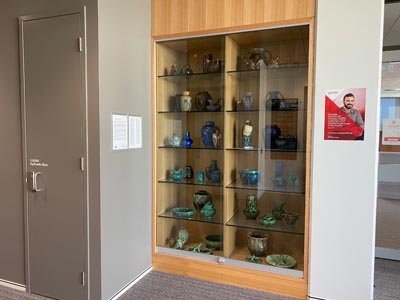
L.J. Harvey School Pottery
L.J. Harvey School Potters
Ceramics (approx. 50 works), pottery
Griffith University Art Collection
Lewis Jarvis (L.J.) Harvey, his students, and the distinctive style of what is now known as the Harvey School were the single biggest influence on Queensland's visual culture in the first half of the 20th century.
Harvey's pottery classes, initated in 1916 at the Central Technical College in Brisbane (precursor to Griffith University's Queensland College of Art and Design), operated over thirty years and encouraged students to work local clays by hand - a distinct and purposeful alternative to factory-made household items during a period of burgeoning mass manufacture.
Today, the Harvey School is recognised in as the largest school of pottery to have existed in Australia. In 2018, Griffith University Art Museum presented an exhibition and major publication on Art Pottery in Queensland between 1900-1950. Entitled 'With Heart & Hand', the project revealed the significant number of women who were practising during the period, many of whom were overlooked by past research or credited as hobbyists or "unknown" creators. New research uncovered the work of regional potters and re-evaluated the role of women in building the state's art sector.
Though at the time they were rarely regarded as professional artists, these women were vitally important to the development and appreciation of pottery in the early 20th century. Their works were exhibted and sold nationally, and afforded them new opportunities as teachers and art therapy facilliators in post-World War I Australia.
Harvey and his students ran successful programs in rehabilitating the manual skills of returned soldiers and children stricken with infantile paralysis, ultimately contributing to the establishment of occupational therapy as a distinct discipline at the University of Queensland in 1955.